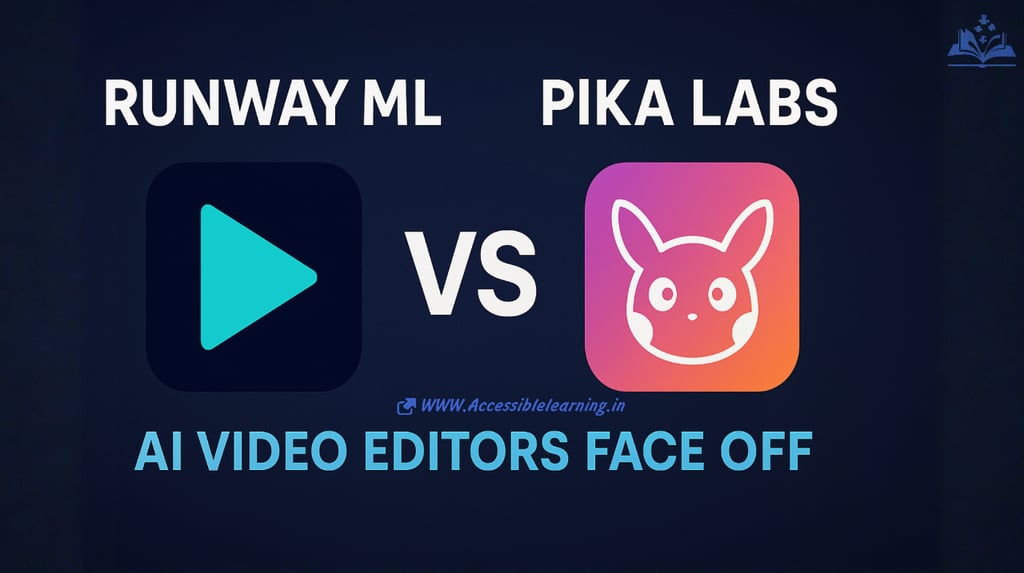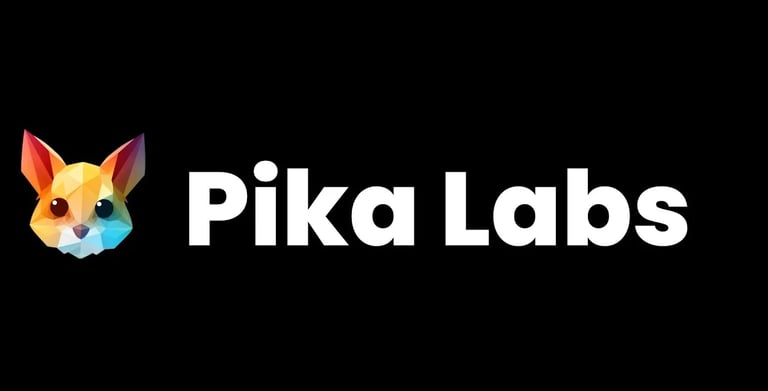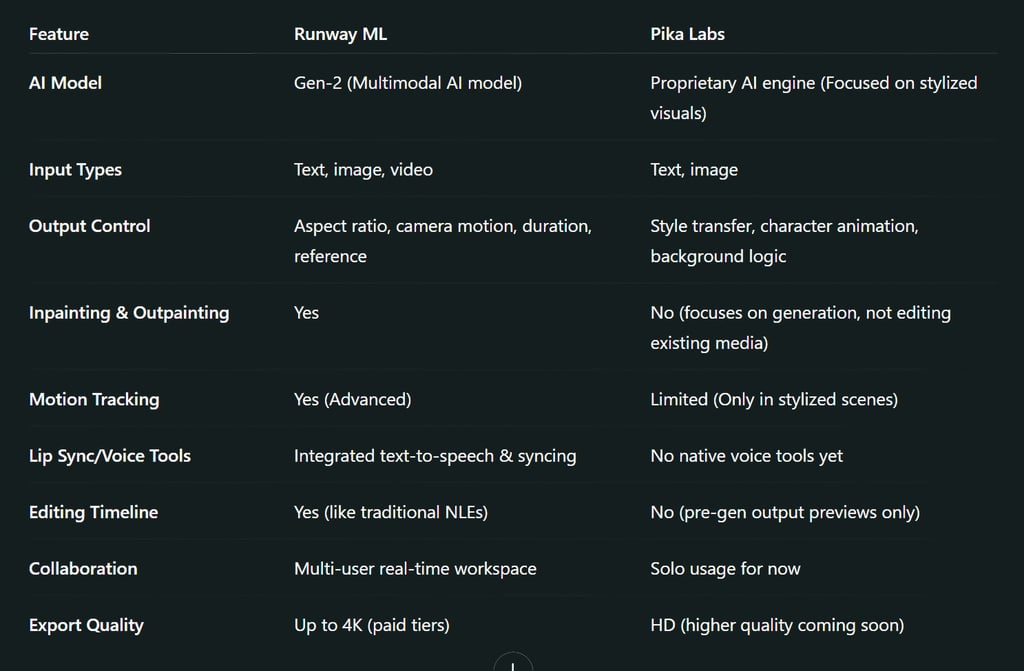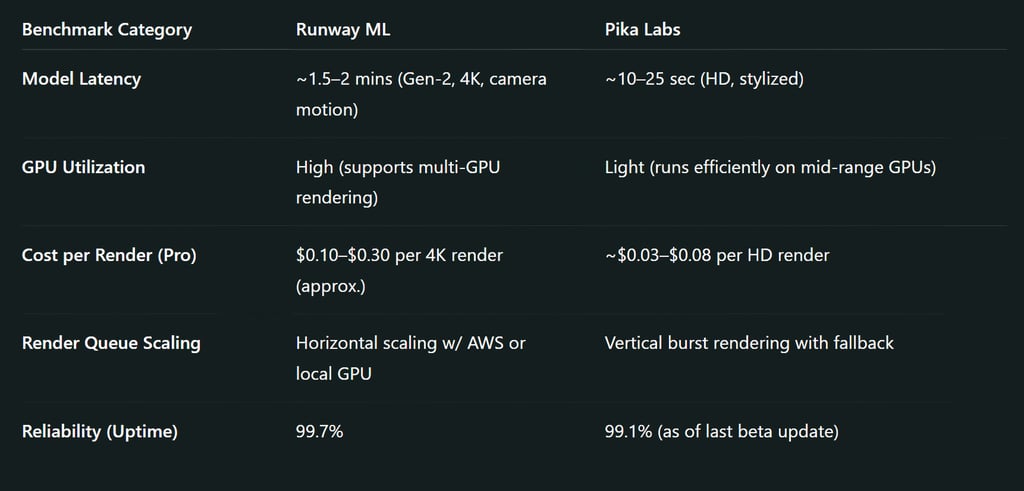
Runway ML vs Pika Labs: AI Video Editors Face Off in the Creative Arena
Explore a detailed comparison of Runway ML and Pika Labs—two top-tier AI video editing platforms. From technical capabilities to creative use cases, find out which tool best fits your content creation goals.
AI/FUTUREEDITOR/TOOLSAI ART TOOLSARTIST/CREATIVITY
Sachin K Chaurasiya
6/27/20255 min read


In today’s fast-evolving digital landscape, video content reigns supreme. From YouTube creators to marketing teams, the demand for rapid, creative, and professional-looking videos is higher than ever. Enter AI video editors like Runway ML and Pika Labs—tools designed to revolutionize how videos are created and edited using artificial intelligence.
But which platform truly delivers for content creators, filmmakers, and brands? Let’s dive into a detailed comparison of Runway ML vs Pika Labs, exploring their features, AI capabilities, user interface, pricing, and ideal use cases.
Runway ML
Runway ML is a pioneer in creative AI tools. With its flagship Gen-2 model, it empowers creators to generate videos from text, image, or video inputs, edit footage using inpainting, and apply motion-tracking effects—all with just a few clicks.
Launch Year: 2018
Headquarters: New York, USA
Focus: Full-suite AI video editing, text-to-video, real-time collaboration, motion tracking, inpainting, and model training.
AI Video Generation Capabilities (Runway ML’s Gen-2)
Runway’s Gen-2 is a multi-modal AI video generator that lets users input a simple text prompt, image, or even a reference video. The model interprets these inputs to generate video scenes with camera motions, visual storytelling, and stylistic coherence.
Key Strengths
Camera fly-throughs and perspective realism
Consistency between frames
Motion style transfer
Precise masking tools for object tracking and replacement
User Interface & Workflow
Clean, professional dashboard
Drag-and-drop editing timeline
Compatible with standard editing formats
Plugin integration for Adobe and other tools
Better for professionals and agencies
Use Cases & Ideal Audience
Video editors and filmmakers
Marketing agencies needing branded content
Educational/Training videos
Virtual production studios
YouTube creators seeking full-edit tools
Model Architecture & Training Approach
Architecture
Gen-2 builds on latent diffusion models (LDMs) with a hybrid spatio-temporal transformer pipeline, enabling video consistency across frames. It works through a dual encoder system for text and image inputs, with a dedicated temporal attention mechanism.
Training Data
Trained on a massive multimodal dataset (text, image, and video triplets), Gen-2 leverages large-scale motion sequences and cinematographic datasets optimized for semantic preservation across frames and time.
Key Innovations
Camera Motion Conditioning: Allows virtual camera movements (dolly, pan, zoom) using vector embeddings.
Depth Map Injection: Uses depth-aware mapping from input frames to improve motion realism.
Inpainting via Dynamic Masking: Spatial transformer networks automatically infer object boundaries to replace or erase elements contextually.


Pika Labs
Pika Labs emerged as a direct competitor in the AI video space, especially excelling in visual storytelling. Its intuitive Discord-based launch attracted early adopters, and its web platform now brings sleek, style-locked animations for creators with an emphasis on character design and expressive outputs.
Launch Year: 2023
Headquarters: San Francisco, USA
Focus: Text-to-video AI, real-time generation, style consistency, creative VFX, and short-form content creation.
AI Video Generation Capabilities (Pika Labs' Engine)
Pika Labs focuses on a stylized storytelling approach. Its text-to-video system excels at producing aesthetic visuals, fantasy-themed outputs, and expressive character-based clips. It’s incredibly popular for TikTok creators, meme editors, and indie animators.
Key Strengths
Consistent character styling
Smooth animations with a cartoon/anime aesthetic
Fast render times (10–30 seconds)
Ability to chain scenes for narrative building
User Interface & Workflow
Originally Discord-based; now has a browser UI
Simpler prompt-driven workflow
Visual style customization with reference images
Ideal for hobbyists, storytellers, and fast content makers
Use Cases & Ideal Audience
TikTok and Instagram Reels creators
Storytellers and comic animators
Indie VFX creators
Fantasy and stylized video fans
Meme makers and short skit producers
Model Architecture & Training Approach
Architecture
While not fully disclosed, Pika Labs is believed to use a lightweight, fine-tuned diffusion model optimized for frame interpolation and stylized motion continuity. It likely includes a StyleGAN-inspired layer for aesthetic enhancement, layered atop a basic frame generator.
Training Strategy
Focused on style-consistent sequences, Pika's training prioritizes character retention, facial expression framesets, and 2.5D animation motion loops. Uses low-latency vector quantization (VQ) to reduce rendering time.
Key Innovations
Prompt-Style Fusion Layer: Combines user-prompt semantics with visual style embeddings for scene coherence.
Auto Loop Smoothing Algorithm: Ensures end-to-start frame continuity for loopable reels.
Scene Chaining with Temporal Gradient Memory: Allows multiple scenes to blend into each other with memory-aware continuity.






Inference Pipeline & Latency Handling
Runway ML
Inference Stack
Uses CUDA-accelerated pipelines, ONNX runtime optimization, and model quantization in lower tiers. Pro accounts benefit from multi-GPU accelerated rendering (A100s or V100s).
Latency Handling
Introduces asynchronous token buffering during prompt-to-video transformation, reducing UI input delays even when the backend is loaded.
Advanced APIs
Runway provides developer APIs to:
Call text-to-video via REST
Manipulate scene graphs
Trigger inpainting tasks programmatically
Integrate with tools like Blender, Unreal Engine, and Unity
Pika Labs
Inference Stack
Likely uses a simplified WebRTC-powered serving mechanism via distributed GPU clusters, optimized for low-batch rendering and real-time Discord feedback during beta.
Latency Handling
Uses dedicated task queues on edge GPU servers with pre-cached style prompts. The result is sub-15s turnaround for most renders—excellent for short content generation.
Developer Access
Pika has limited APIs currently but plans to launch
Prompt templating SDKs
Real-time character generator API
Scene blending from script-to-video pipelines
Advanced Use Cases & Experimental Integrations
Runway ML
Virtual Production Pipelines
Runway is already being integrated into virtual film studios to test camera motion, lighting scenarios, and environment pre-visualization.
AI Film Editors Toolkit
Features like motion brush, object masking, and “AI Replace” are part of a broader vision for cinema-quality automation, particularly useful in storyboarding, previs, and rough cuts.
Multi-modal R&D
Runway’s Gen-2 roadmap includes:
Audio-reactive generation
Emotion-conditioned scenes
Reinforcement learning-enhanced edits
Pika Labs
Narrative Video Chains
Advanced users use prompt chaining to create multi-scene animated micro-stories (a technique similar to storyboard merging).
Custom Style Tokens (Beta Users)
Some power users can inject personal art styles or anime themes using uploaded reference datasets.
Voice-to-Video (Experimental)
Future builds are expected to accept voice prompts to influence scene emotion and pacing—opening doors to narrative-driven animation from spoken input.

Community & Support
Runway ML has robust documentation, community forums, and enterprise support.
Pika Labs thrives on Discord with active user feedback, sharing, and prompt advice.
Both communities are enthusiastic, but Runway leans professional, while Pika fosters creative experimentation.
In the battle of Runway ML vs Pika Labs, the winner depends entirely on your creative goals.
Choose Runway ML if you want professional-grade editing tools, camera realism, and inpainting/masking for detailed video work.
Choose Pika Labs if you’re into fast-paced, stylized storytelling, character-driven content, or short-form social media videos with vivid imagination.
Both tools are pushing boundaries—but in very different directions. The future of AI video editing will likely include features from both ecosystems. Until then, let your vision dictate your tool.
FAQs
Q: Can I use Runway ML and Pika Labs together?
Yes! Many creators generate visuals in Pika Labs and finalize edits in Runway for polish.
Q: Which tool is better for animation-style videos?
Pika Labs excels at anime and stylized animations, while Runway is better for realism.
Q: Are both platforms browser-based?
Yes, both are accessible via browsers without needing downloads.
Q: Which offers better free value?
Pika Labs currently offers more for free, with fast render times and quality outputs.
Q: Are these tools beginner-friendly?
Pika Labs is extremely beginner-friendly. Runway ML, while intuitive, has a steeper learning curve due to its depth.
Subscribe To Our Newsletter
All © Copyright reserved by Accessible-Learning Hub
| Terms & Conditions
Knowledge is power. Learn with Us. 📚


